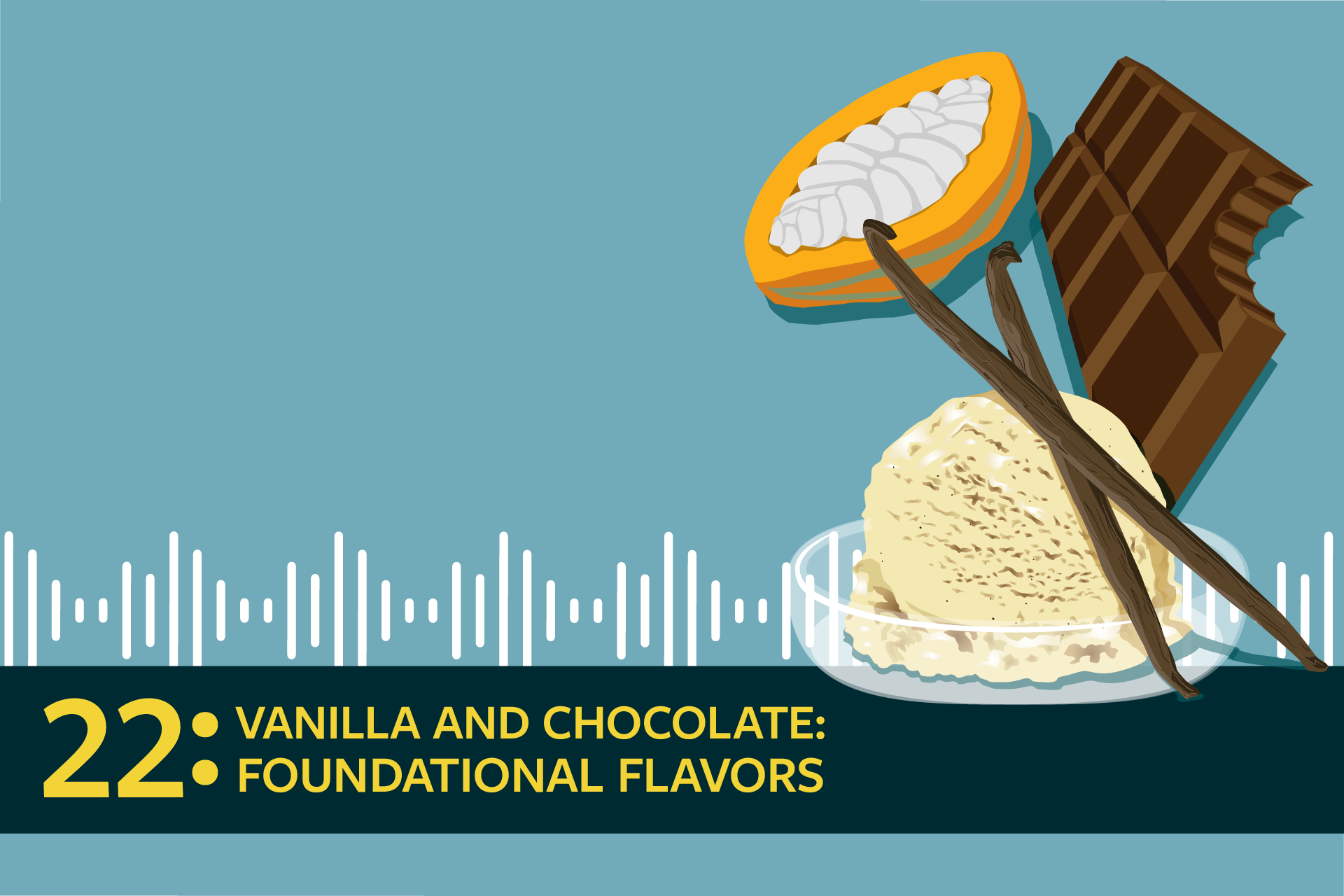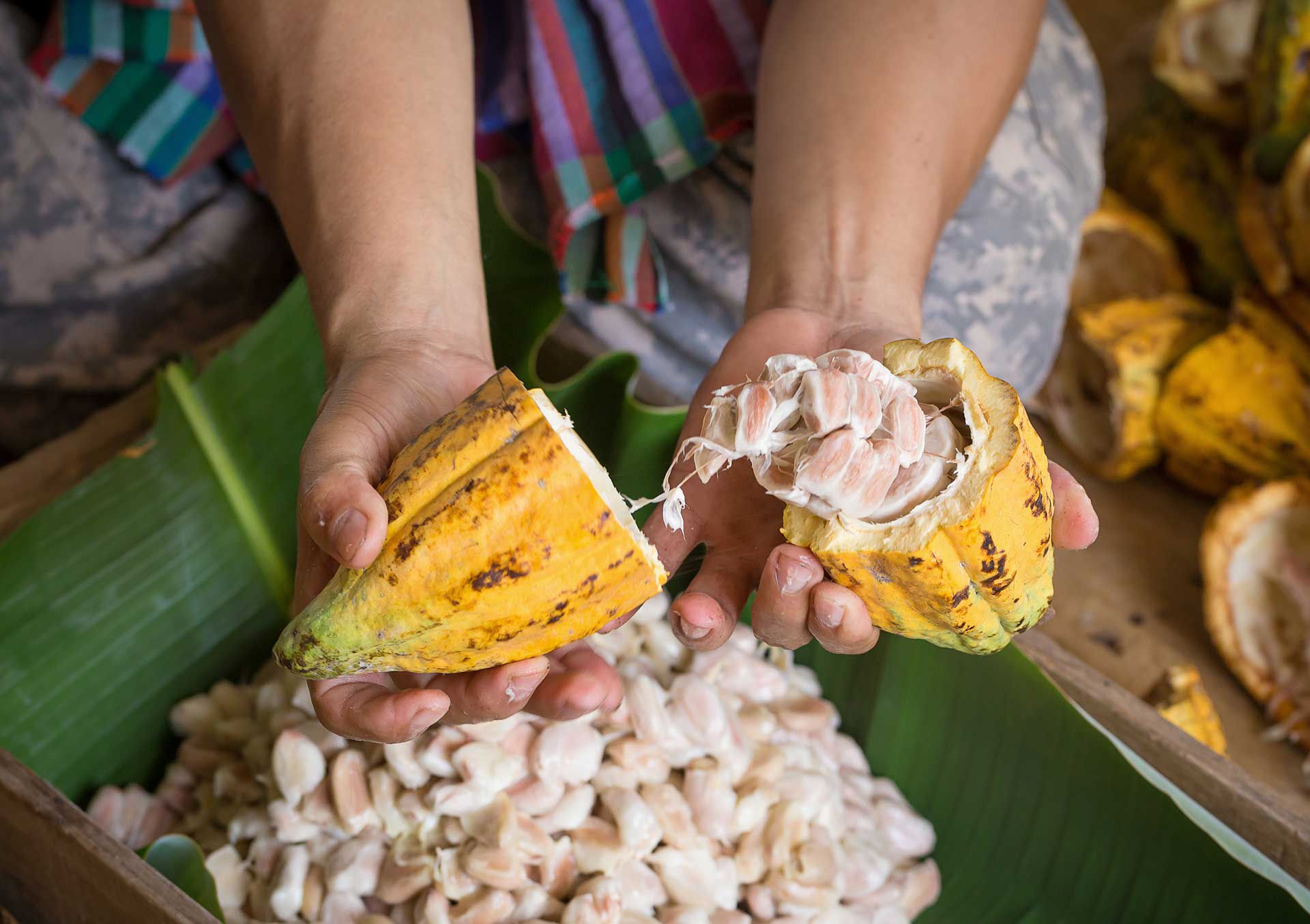Real Food Encyclopedia | Chocolate
Between Halloween candy, Valentine’s day truffles, cakes, hot cocoa and ice cream, chocolate is everywhere. Our love affair with chocolate is one of the world’s oldest romances — archeologists have found evidence of chocolate consumption in Mexico as early as 1900 BCE. Long enjoyed as a bitter, rich drink by the Mayans and the Aztecs, chocolate was transformed into the confection we know today by Europeans. Unfortunately, between issues with deforestation and an ongoing child labor crisis, the chocolate industry today isn’t as sweet as its product. Choosing chocolate that is sustainably and ethically produced can be a challenge.
Did you know?
- For Spanish-speakers, “cacao” is the only way to refer to raw chocolate, and many people believe the term “cocoa” came from a spelling mistake.
- White chocolate isn’t technically chocolate (as judged by chocolatiers, and the FDA).
- American chocolate tastes different from other countries’ because it includes butyric acid, which is a byproduct of Milton Hershey’s secret “Hershey Process.” So many Americans associate its tangy taste with chocolate that other manufactures will add it in.
What to look for when buying chocolate
There are many different types of chocolate, see the “Types of Chocolate” below for more information on the best kinds of chocolate for different uses.
As with most processed foods, pay close attention to the ingredients list. Are there a lot of added sugars, additives, gums, carrageenan, et cetera? If so, look for more simple alternatives.
Rather than looking for the right certification, look for companies with good practices, those who do “direct trade” and can tell you on their website who their farmers are. There are many certifications on chocolate that pruport to give farmers a living wage or to protect the environment, but experts say they often fall far short of their promises. As program director Anna Canning told us in an interview, “Instead of a certified bar from a company who’s also getting sued by formerly enslaved former child laborers, look to invest in the long-term — supporting companies working to build a different kind of supply chain and industry.”
Production
Because we mostly encounter it in cakes and candies, it’s easy to forget that chocolate is a fresh product that comes from a tropical plant. Cocoa trees grow best within 20 degrees of latitude from the equator and need a lot of rain — about four inches a month, so this limits their production to tropical areas. Nearly three quarters of the world’s chocolate is produced in the West African countries of Ivory Coast, Ghana, Nigeria and Cameroon, with the rest coming from South America and Southeast Asia.
There are three main types of cacao: Criollo, Forastero and Trinitario. Criollo beans, which are mainly grown around the Caribbean, produce a complex cocoa, with notes of fruit and spices. Criollo beans are generally reserved for fine chocolate making. Forastero beans have a more intense, heavy chocolate flavor, and account for the majority of the cacao produced today. The third kind, Trinitario, is a cross between the other two varieties.
Chocolate pods grow year round but are harvested typically twice a year, with the timing depending on where they’re grown. After harvesting, cacao beans are removed from their pods and fermented for several days to develop flavor. The fermented beans are then dried in the sun and shipped to factories where they are roasted and ground into a liquid mix called chocolate liquor. That liquor — which isn’t alcoholic — contains both cocoa solids and cocoa butter. Cocoa solids give the rich chocolate flavor, while cocoa butter imparts a smooth and creamy texture.
Types of Chocolate
As Bon Appetit explains, different kinds of chocolate products have different proportions of cocoa solids and cocoa butter, along with other mix-ins.
- Cocoa powder – cocoa powder is made entirely from cocoa solids after the cocoa butter is removed. Cocoa powder can be used in baked goods and drinks to impart a strong chocolate flavor without the fat that comes with the cocoa butter.
- White chocolate – white chocolate contains no cocoa solids, only cocoa butter, sugar and dairy, giving it a light and creamy taste with no traditional chocolate flavor.
- Milk Chocolate – milk chocolate contains at least 10% chocolate liquor, with an additional 12% dairy for added creaminess. Sugar, vanilla and other flavorings help milk chocolate balance between sweet, light flavors and a more intense chocolate taste.
- Dark chocolate – dark chocolate contains the highest percentage — at least 35% — of cocoa solids and butter, with some added sugar. Dairy may be added to dark chocolates, but in minimal amounts to preserve the intensity of chocolate flavor.
In addition to dairy, sugar and flavorings, some chocolates may contain other ingredients like soy lecithin or palm oil to help them maintain an even texture or to prevent them from melting.
Sustainability of chocolate
Chocolate — like coffee — has a high environmental impact. Both are grown in tropical forests, and while chocolate can be grown in the shade and integrated into forests with little disturbance, it’s more productive in full sun. This means the farmers trying to make ends meet often clear large patches of rainforest to make way for chocolate, making it a major driver of deforestation; Ivory Coast, the world’s top cocoa producer, has lost 80 percent of its forests in the last 50 years. Growing and processing chocolate also takes a lot of water — about 450 gallons to make a typical 3.5 ounce chocolate bar.
The other ingredients in some chocolate products, like dairy, sugar, and soy, all come with their own foodprints. Palm oil, which is added to many candies for gloss and heat resistance, is a major driver of habitat loss and deforestation.
Pesticides
Because cacao is mainly produced on small, remote farms in the tropics, information on pesticide use is inconsistent. Chemical use on chocolate farms is also a trade-off; while pesticides and fertilizers damage the environment, farmers who can’t afford to use them often end up cutting down more forest to keep up on production. Organic management of cocoa is possible, but the market for organic beans is currently very small.
Labor Issues
There are serious social and economic justice concerns with chocolate production. Consumers in the U.S. and Europe expect cheap chocolate, which means that the farmers who grow cocoa beans get paid very little. As a result, many cacao farmers in West Africa rely on unpaid child labor. Sometimes these children are members of the farmers’ families who cannot afford school fees, but sometimes the children are victims of human trafficking from neighboring countries.
Voluntary third-party certification is another route companies take to try and address the ongoing labor issues with chocolate, but none of the labeling schemes are perfect. Fairtrade provides a price premium for local coops in exchange for good practices, and Rainforest Alliance (which merged with UTZ to become the largest certifier in 2018) also conducts audits to certify chocolate farms audits aren’t displacing forests or using child labor. However, even these third-party certifications aren’t always accurate; the Washington Post reported that Rainforest Alliance-certified chocolate was actually more likely to come from farms that used child labor than chocolate without certification.
Finding good chocolate labels
With so much uncertainty around labeling, certification and supply chains, it’s hard to know how to buy chocolate that is ethically and sustainably produced.
Unfortunately, there isn’t one label that successfully incorporates the whole suite of environmental and social concerns with chocolate production. For environmental sustainability, USDA certified organic is a good place to start. First, buying organic ensures that both the cocoa and the other ingredients in the chocolate — dairy, sugar, flavorings and emulsifiers — aren’t being produced with chemical fertilizers and pesticides that can harm the environment. Second, since organic cocoa beans are mainly produced in Central and South America, buying organic cocoa sidesteps the labor issues in West Africa.
If you are looking to support companies who do not have any forced labor in their supply chains, check out this frequently updated list of ethical companies on slavefreechocolate.org.
Generally, buying more sustainably produced chocolate means paying a higher price, since both the negative environmental and social impacts are driven by the low prices farmers receive. Chocolate companies respond to the interests of their customers, and sustainably produced chocolate is a growing part of the industry, especially among young consumers. Until chocolate companies are able to deliver on their commitments, avoiding mass-produced candy bars with no certification standards is a good idea to help reduce the demand for low priced, unsustainable cocoa. Treat chocolate like the decadent, rare indulgence it is — buy a high quality product, pay a fair price for it, and savor every bite.
How to cook chocolate
Storing
Chocolate should be stored in a cool, dark place. Chocolate’s melting point — between 86 F and 90 F — gives it a melty mouth feel, but also makes it difficult to store for long periods. Chocolate stored in warm areas may show bloom, which is when some of the fats come to the surface of the bar in a greyish-white film. While bloomed chocolate might look unappetizing, it’s perfectly safe to eat. If presentation is important, melting and recooling the chocolate takes care of the bloom, so it won’t show up in chocolate chip cookies or other baked goods.
Cooking
While most of the chocolate we eat comes in candy bars, there are many more ways to enjoy it. Chocolate is used around the world in many savory dishes, like Oaxacan mole and Texas Chili, where it rounds out sharper, spicier flavors.
Nutrition
Unprocessed cacao nibs are a significant source of flavonoids and other antioxidants, and there’s some medical evidence to suggest regularly consuming dark chocolate might benefit cardiovascular health. Still, most chocolate is high in sugar and fat, so it’s best to consume it in moderation.
Chocolate contains small amounts of theobromine, a compound similar to caffeine. While humans aren’t harmed by theobromine, it is toxic to many animals, especially dogs, so be careful to store chocolate where your pets can’t reach it.
Top photo by Norman Chan /Adobe Stock.


